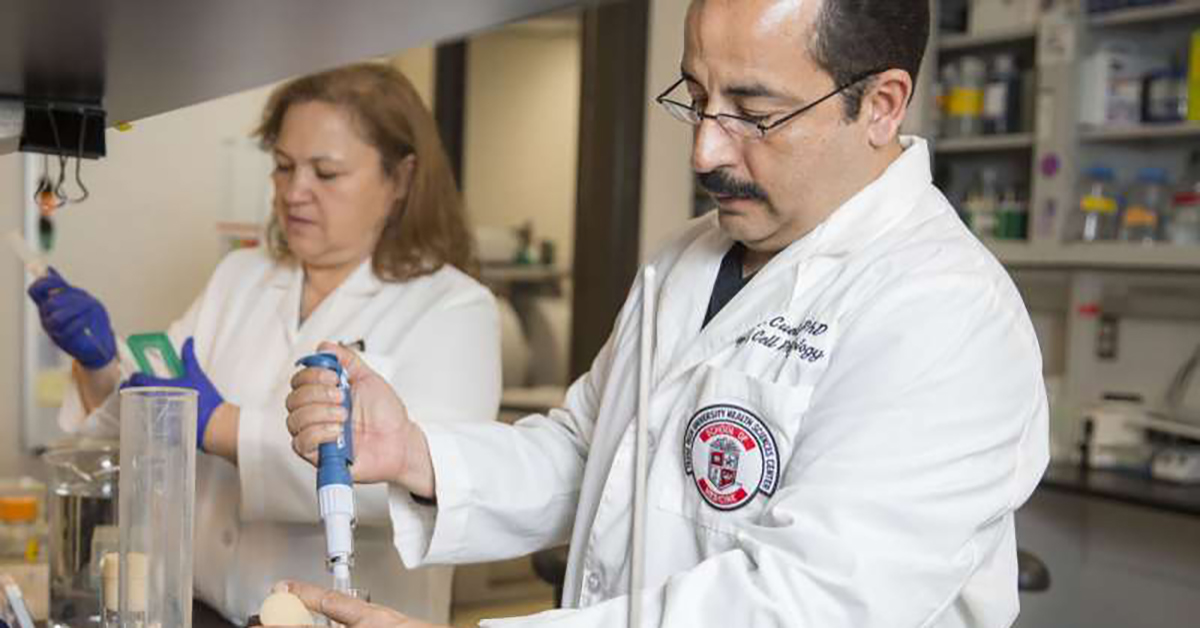Research team reverse way potassium channels work from bacteria to human
Research paves way for smart-design of therapeutic drugs for potassium channel-related diseases

For the first time ever, researchers at the Texas Tech University Health Sciences Center (TTUHSC) have identified a specific amino acid residue that is responsible for inverting the communication between the opening of the activation gate and the inactivation of a potassium channel's selectivity filter. The study was published in the Proceedings of the National Academy of Sciences (PNAS) of the United States of AmericaApril issue.
Luis G. Cuello, Ph.D., associate professor in the TTUHSC Department of Cell Physiology and Molecular Biophysics and director of the Core Facility Laboratory of the Center for Membrane Protein Research, said his research team was able to reverse the way potassium channels work from bacteria to human.
"Normally, a potassium channel opens the activation gate and manages ion conduction for hundreds of milliseconds, then because the activation gate and the filter cross-talk, the filter undergoes a change in its conformation that yielded its collapse, which ceases ion conduction, inactivating the channel," Cuello said.
Potassium channels are extremely specialized proteins that are embedded in a membrane that is surrounding any living cell. By closing and opening a narrow constriction known as the activation gate, they control the transport of potassium ions in and out of the cell. The selectivity filter of potassium channels is the region within the protein structure in charge of the selective discrimination between potassium and sodium ions, which are about the same size. Cuello said this area of the protein procures a passage that perfectly fits potassium ions but is incapable to accommodate sodium ions, which makes it "selective" for potassium ions. The filter also can act as a secondary gate in series to the activation gate.
"We established this before by solving the crystal structure of an open potassium channel," Cuello said. "The opening of the activation gate induces the collapsing of the selectivity filter which preclude the flow of ions through it despite having the activation gate open. The collapsing of a potassium channel is the underlying cause for a process known as C-type inactivation, which makes the selectivity filter the C-type inactivation gate."
Potassium channels are proteins that are made of amino acid residues. A THREONINE is one of the 20 different amino acid residues that a cell uses to build a protein molecule. Cuello's lab identified a Threonine residue (Threonine 75) as a crucial player that communicates the opening of the activation to the channel selectivity filter.
Allosteric coupling refers to the communication between two regions within a protein structure. Many therapeutic drugs bind to a specific site within the protein structure (binding site) and produce an effect somewhere else within the protein (effector site). Identifying the network of the amino acid residues that proteins use to couple two distant sites is an important step toward understanding at the atomic level how proteins regulate all the physiological aspects within the human body.
Cuello's research found a way to reverse this process in a mutant channel, the threonine to alanine mutation in channels from bacteria all the way up to humans reverts the process. These mutant channels have a selectivity inactive filter when the activation gate is closed and resets to a conductive conformation when the activation gate is open.
"With this study, we gain unprecedented knowledge and control over these types of channels," Cuello said. "By developing a better understanding and exerting an unparalleled control of these type of molecules, we are paving the road toward the smart-design and synthesis of novel and safer therapeutic drugs to correct illnesses associated to with the dysfunction of potassium channels."
Related Stories
Celebrating Veterans: TTUHSC’s General Martin Clay’s Legacy of Service and Leadership
From his initial enlistment in the Army National Guard 36 years ago to his leadership in military and civilian health care management roles, Major General Martin Clay’s career has been shaped by adaptability, mission focus and service to others.
Texas Tech University Health Sciences Center School of Nursing Named Best Accelerated Bachelor of Science in Nursing Program in Texas
The TTUHSC School of Nursing Accelerated Bachelor of Science in Nursing (BSN) program has been ranked the No. 1 accelerated nursing program in Texas by RegisteredNursing.org.
TTUHSC Names New Regional Dean for the School of Nursing
Louise Rice, DNP, RN, has been named regional dean of the TTUHSC School of Nursing on the Amarillo campus.
Recent Stories
Making Mental Health a Priority in the New Year
Sarah Mallard Wakefield, M.D., a psychiatrist with Texas Tech Physicians, talks about strategies to combat widespread and growing anxiety.
TTUHSC Cancer Researcher Honored by National Academy of Inventors
C. Patrick Reynolds, M.D., Ph.D., director of the School of Medicine Pediatric Cancer Research Center at TTUHSC, has dedicated his life as a researcher to developing treatments for childhood cancers.
TTUHSC School of Nursing Celebrates 10 Years of the Veteran to BSN Program
The TTUHSC School of Nursing recognized the 10-year anniversary of the Veteran to Bachelor of Science in Nursing (VBSN) program during the fall 2025 commencement ceremonies held Dec. 13 in Lubbock, Texas.
